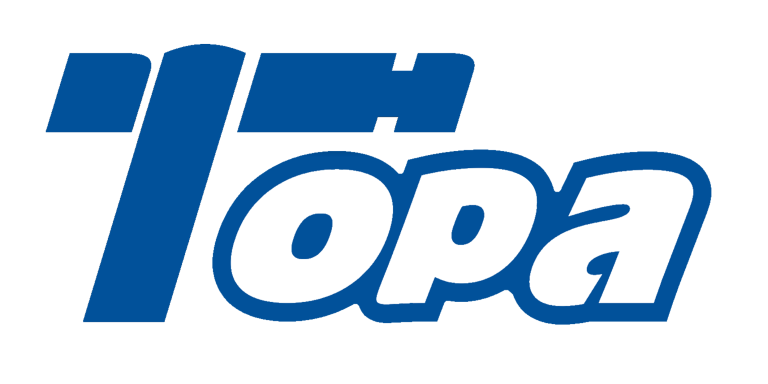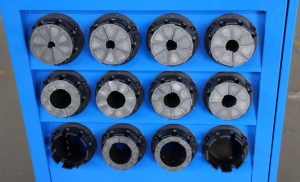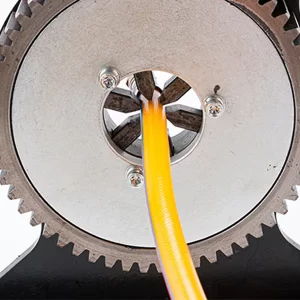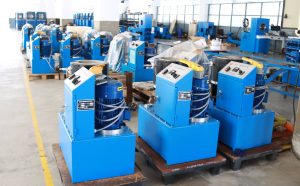Starting with a proper hydraulic hose crimper starter kit is vital for any business dealing with hydraulic hose assembly. This article titled “What Essentials Should a Hydraulic Hose Crimper Starter Kit Include?” explores every must-have component that ensures your operation runs smoothly and efficiently from day one. But here’s the kicker: having a complete and well-thought-out starter kit can save you time, reduce errors, and improve the quality of your hose assemblies significantly. From the crimper machine to hand tools, safety gear, and training materials, we’ll break down what you absolutely need to begin professional hydraulic hose crimping. Whether you’re launching a new workshop or upgrading your capabilities, this guide sets you up for success.
1. What is a hydraulic hose crimper starter kit and why is it important?
A hydraulic hose crimper starter kit contains all the fundamental tools and components necessary to start assembling hydraulic hoses effectively. It is important because it provides everything from the crimping machine to essential accessories, enabling consistent, safe, and high-quality hose assembly. Ready for the good part? Without the right starter kit, businesses risk inefficient processes, poor-quality crimps, and increased downtime. For example, a small repair shop investing in a comprehensive starter kit reduced assembly errors by 30% within six months. Similarly, a manufacturing line avoided costly delays by having all necessary tools at hand from the start. The kit typically includes not only the crimper but also cutters, dies, fittings, safety equipment, and measurement tools. This all-in-one approach streamlines workflow and minimizes the learning curve for operators.
| Starter Kit Component | Purpose | Business Benefit |
|---|---|---|
| Crimper Machine | Performs hose assembly crimps | Consistent quality and speed |
| Hand Tools | Cutting, stripping, measuring | Precise hose preparation |
| Safety Equipment | Operator protection | Reduced workplace accidents |
| Quality Control Tools | Inspection and measurement | Ensures defect-free assemblies |
2. What basic tools must be included in a starter kit?
The basic tools form the backbone of any hydraulic hose crimper starter kit. First, the crimper machine itself is essential; it should match your production volume and hose types. Manual, semi-automatic, and automatic crimpers offer different advantages depending on your needs. But here’s the kicker: pairing the machine with quality hand tools like hose cutters and wire strippers ensures precise hose preparation. Measuring tools such as tape measures and micrometers are necessary for accurate hose lengths and crimp diameters. A recent case study from a maintenance company revealed that introducing a proper cutter and stripper with their crimper improved overall assembly time by 25%. Without these tools, operators risk making uneven cuts or improper crimps that can cause failures.
| Tool Type | Function | Example |
|---|---|---|
| Hydraulic Hose Crimper | Assembles hoses | Semi-automatic or manual |
| Hose Cutter | Cleanly cuts hose to length | Precision rotary cutters |
| Wire Stripper | Removes hose reinforcement | Adjustable blade strippers |
| Measuring Tools | Ensures accurate lengths | Tape measures, micrometers |
3. What types of hydraulic hoses and fittings should be part of the kit?
A starter kit must include a range of commonly used hydraulic hoses and fittings to cover most job requirements. Hose types often included are rubber, thermoplastic, and braided hoses with varying pressure ratings. This is where it gets interesting: having several sizes and lengths on hand ensures flexibility. Likewise, fittings such as JIC, ORFS, and metric adapters are essential to connect hoses reliably. A hydraulic service center improved job turnaround by 40% after expanding their starter kit to include a broader range of hose materials and fitting types. Material compatibility is critical; using mismatched hoses and fittings can lead to leaks or failures. Including manufacturer-recommended fittings with clear labeling prevents costly errors.
| Hose Type | Pressure Rating | Common Applications |
|---|---|---|
| Rubber Hose | Up to 4000 PSI | General hydraulic systems |
| Thermoplastic Hose | Moderate pressure | Light machinery |
| Braided Hose | High pressure up to 6000 PSI | Heavy equipment |
| Fitting Type | Description | Compatibility |
|---|---|---|
| JIC (Joint Industry Council) | 37-degree flare fittings | Widely used standard |
| ORFS (O-Ring Face Seal) | Leak-free sealing | High-pressure applications |
| Metric Fittings | Metric thread systems | European and Asian markets |
4. How important are dies and crimping jaws in a starter kit?
Dies and crimping jaws shape the hose fitting during assembly, making them critical components of any starter kit. You need a variety of dies covering the hose sizes and fitting types you intend to work with. But here’s the kicker: using the wrong die size leads to poor crimps and hose failure. For example, a factory experienced frequent leaks until they replaced worn dies with correctly sized ones and saw a 50% defect reduction. Maintenance is also key; clean dies ensure consistent crimps and extend tool life. Including spare dies in the kit minimizes downtime from replacements.
| Die Size Range | Hose Diameter Coverage | Replacement Frequency |
|---|---|---|
| Small (1/4” – 3/8”) | Light hoses | Every 6-12 months |
| Medium (1/2” – 1”) | Standard hydraulic hoses | Every 12 months |
| Large (1 1/4” – 2”) | Heavy-duty hoses | Based on wear |
5. What safety equipment should be included in a hydraulic hose crimper kit?
Safety gear protects operators during hydraulic hose assembly, making it a must-have in any starter kit. Essential personal protective equipment (PPE) includes gloves, safety glasses, and ear protection. Machine guards and lockout mechanisms ensure the crimper operates safely. This is where it gets interesting: a company that introduced mandatory PPE and machine guards reduced workplace injuries by 35%. Safety training materials, including manuals and checklists, reinforce proper protocols. Having this equipment readily available in the starter kit encourages consistent safe practices.
| Safety Equipment | Purpose | Benefit |
|---|---|---|
| Safety Gloves | Protect hands from cuts | Reduced injury rates |
| Safety Glasses | Shield eyes from debris | Prevent eye injuries |
| Ear Protection | Reduce noise exposure | Prevent hearing loss |
| Machine Guards | Physical barriers | Prevent accidents |
6. How does hydraulic fluid and lubrication factor into the starter kit?
Hydraulic fluids and lubricants are essential for the smooth operation and maintenance of the crimper machine. Proper fluid types maintain hydraulic pressure and prevent internal wear. Lubricants keep moving parts operating smoothly, extending machine life. Ready for the good part? Incorrect or contaminated fluids cause machine failures and costly downtime. A workshop that switched to recommended fluids reduced breakdowns by 20%. Proper storage containers and handling instructions included in the starter kit help maintain fluid quality and safety.
| Fluid Type | Use | Storage Requirement |
|---|---|---|
| Hydraulic Oil | Power transmission | Sealed, temperature-controlled |
| Lubricating Grease | Moving parts lubrication | Clean, dry containers |
7. What measurement and quality control tools are necessary?
Measurement tools in a starter kit ensure crimps meet specifications and maintain high quality. Crimp diameter gauges check crimp size, while micrometers measure hose lengths accurately. Pressure testers verify hose integrity post-assembly. But here’s the kicker: using these tools prevents defective products and warranty claims. A service center introduced pressure testing and cut their return rate by half. Visual inspection tools, such as magnifiers, help detect subtle defects.
| Tool Type | Purpose | Example |
|---|---|---|
| Crimp Diameter Gauge | Verify crimp size | Digital and mechanical models |
| Micrometer | Measure hose length | Precision measurement |
| Pressure Tester | Test hose integrity | Hydraulic pressure gauges |
8. How should a starter kit address hose preparation needs?
Proper hose preparation is crucial for successful crimping. Starter kits must include cleaning supplies, cutting tools, and accessories for end preparation. Clean hoses prevent contamination that causes seal failures. Precision cutters ensure even ends for uniform crimps. What’s the real story? A company improved first-pass yield by 30% after introducing standardized preparation tools and procedures. End caps and deburring tools also protect hose integrity during assembly.
| Preparation Tool | Function | Benefit |
|---|---|---|
| Cleaning Solvents | Remove contaminants | Better seal and crimp |
| Hose Cutters | Precise cutting | Uniform hose ends |
| Deburring Tools | Smooth hose edges | Prevent damage |
9. What documentation and training resources belong in a starter kit?
Documentation guides proper operation, maintenance, and safety. Manuals provide step-by-step instructions, while safety checklists remind operators of precautions. Ready for the good part? Video tutorials enhance learning and reduce errors. A business that combined manuals with video training saw operator errors drop significantly. Access to manufacturer support and troubleshooting guides improves ongoing performance and confidence.
| Resource Type | Purpose | Format |
|---|---|---|
| Operation Manuals | Equipment use | Printed and digital |
| Safety Checklists | Remind safety protocols | Laminated cards |
| Video Tutorials | Demonstrate procedures | Online or USB drives |
10. How does storage and organization solutions enhance a starter kit?
Organized storage keeps tools and parts accessible and protected. Toolboxes, racks, and labeled bins help maintain order. But here’s the kicker: portable cases enable mobility for field work. A maintenance firm improved efficiency by 20% with organized kits and clear labeling. Proper storage also prolongs tool life by preventing damage and loss.
| Storage Solution | Purpose | Example |
|---|---|---|
| Toolboxes | Organize hand tools | Lockable, portable designs |
| Part Bins | Store fittings and dies | Clear, labeled compartments |
| Portable Cases | Mobility for fieldwork | Durable and compact |
11. What are the benefits of including spare parts in a starter kit?
Having spare parts like seals, dies, and hoses prevents downtime when parts wear out or fail. This is where it gets interesting: quick replacements keep operations running smoothly. One company reduced repair time by 50% after stocking common spare parts. Spare parts management in the starter kit should include inventory tracking to reorder timely.
| Spare Part | Function | Benefit |
|---|---|---|
| Dies | Crimp formation | Immediate replacement |
| Seals | Prevent leaks | Maintain hydraulic pressure |
| Hose Sections | Replace damaged hoses | Reduce assembly delays |
12. How can a starter kit be customized for specific industries or applications?
Different industries require tailored kits with specialized hoses, fittings, and tools. For example, mining might need heavy-duty hoses, while automotive shops use smaller sizes. Ready for the good part? Custom kits enhance efficiency and reduce unnecessary inventory. A rental company created kits for specific equipment lines, cutting assembly errors by 30%. Assessing your industry needs ensures the kit fits your workflows.
| Industry | Custom Components | Benefit |
|---|---|---|
| Mining | Heavy-duty hoses, robust dies | Durable and safe assemblies |
| Automotive | Small diameter hoses | Precision for tight spaces |
| Agriculture | Corrosion-resistant fittings | Long-term reliability |
13. What role does budget play in assembling a starter kit?
Balancing essentials and budget is critical when building a starter kit. Entry-level kits may omit automation or advanced tools, focusing on core needs. But here’s the kicker: investing in quality components prevents costly failures. A startup opted for a mid-range kit balancing cost and features and achieved strong ROI. Financing options can make higher-end kits accessible. Budget planning should consider long-term savings from reliability and efficiency.
| Budget Level | Kit Features | Suitable For |
|---|---|---|
| Entry-Level | Basic tools and manual crimper | Low volume or startups |
| Mid-Range | Semi-automatic crimper, quality tools | Growing businesses |
| Advanced | Automated crimper, extensive tools | High-volume or industrial |
14. How does supplier reputation influence the quality of starter kit components?
Supplier reputation affects component reliability, warranty support, and service quality. What’s the real story? Trusted suppliers provide tested, certified parts that meet standards. A company switched to a reputable supplier and saw a 40% reduction in warranty claims. Supplier support includes training, technical help, and parts availability. Checking certifications and customer feedback guides selection.
| Supplier Factor | Impact | Evaluation Criteria |
|---|---|---|
| Quality Certification | Product reliability | ISO, CE marks |
| Customer Support | Warranty and service | Response time, reviews |
| Technical Training | Operator competency | Training programs offered |
15. How can businesses ensure their hydraulic hose crimper starter kit stays updated?
Regular audits of tools, parts, and training materials keep the starter kit current. Ready for the good part? Incorporating new technology, hoses, or fittings improves competitiveness. Feedback from operators identifies needed improvements. Scheduled reviews prevent kit obsolescence. A company instituted annual updates and saw continuous performance improvements.
| Update Activity | Frequency | Benefit |
|---|---|---|
| Tool and Part Audit | Annually | Maintains kit relevance |
| Training Refresh | Biannually | Keeps skills current |
| Technology Upgrades | As available | Improves efficiency |
FAQ Section
Q1: What is a hydraulic hose crimper starter kit?
A starter kit includes all essential tools and components needed to begin hydraulic hose crimping operations efficiently and safely.
Q2: How do crimping dies work in a starter kit?
Dies shape the hose fittings by applying pressure to create a secure, leak-proof crimp.
Q3: Why is safety equipment important in a starter kit?
Safety gear protects operators from injury and ensures compliance with safety standards.
Q4: What measurement tools are essential for quality control?
Tools like crimp diameter gauges and pressure testers ensure crimps meet specifications.
Q5: How often should a starter kit be updated?
Regular reviews and updates ensure the kit stays current with technology, wear parts, and training needs.




